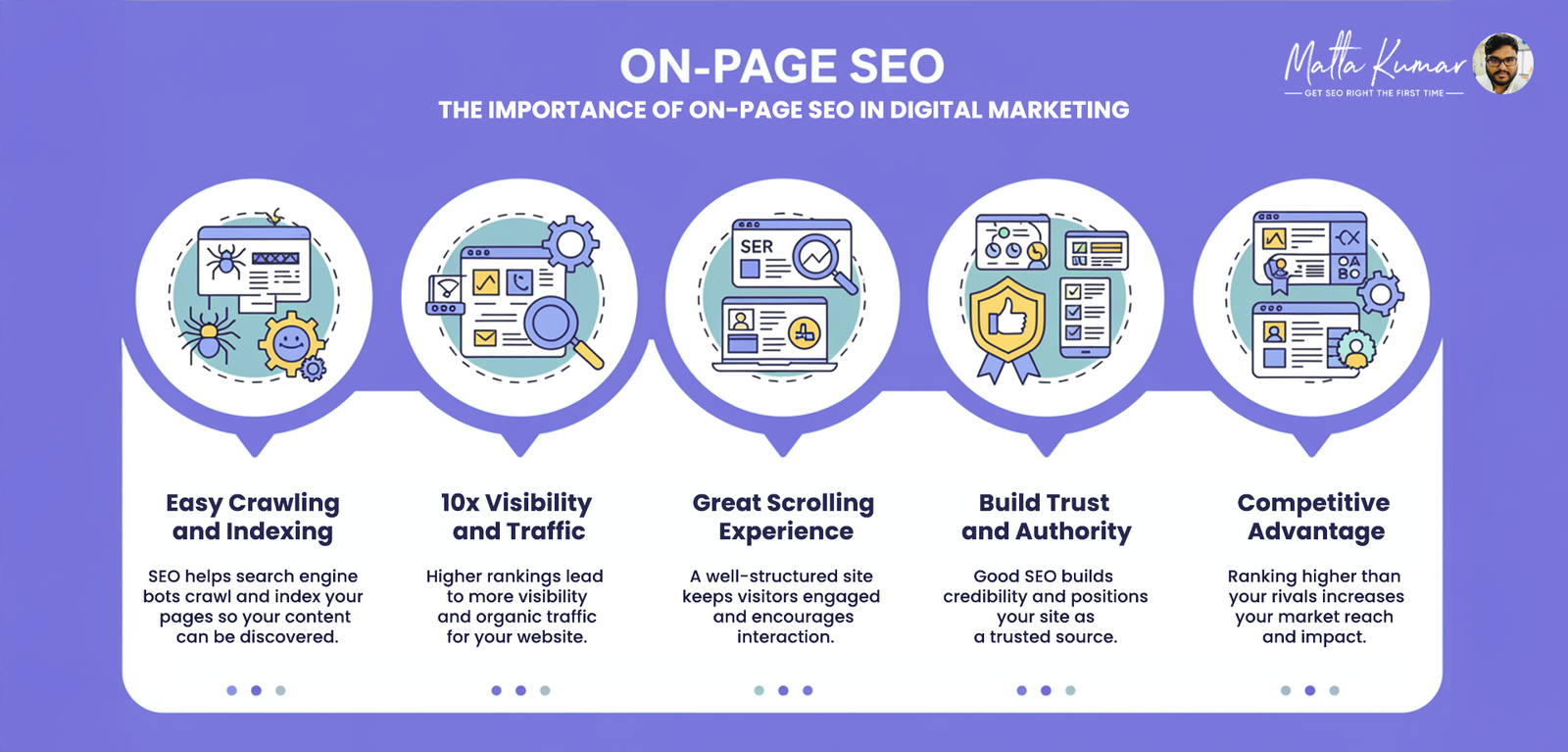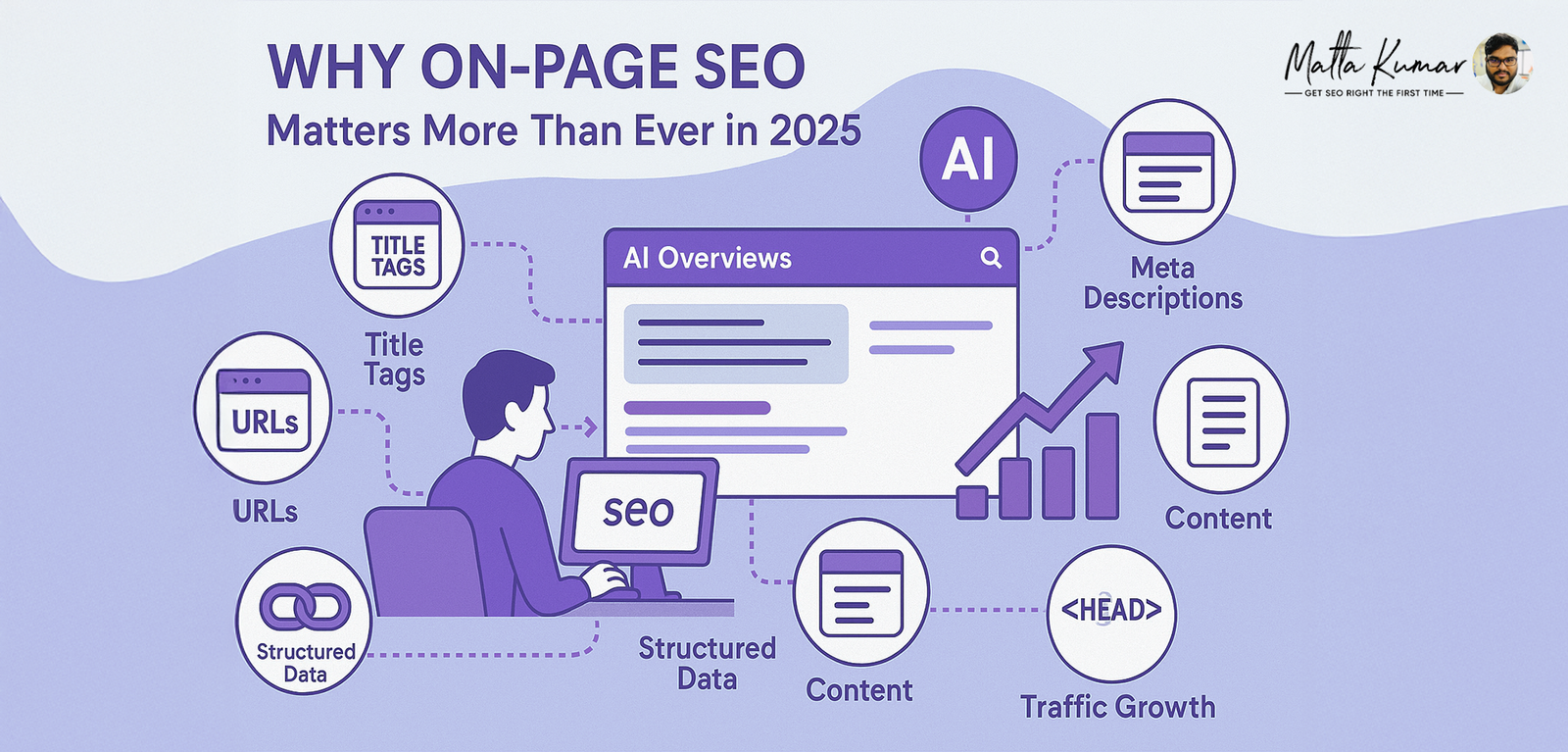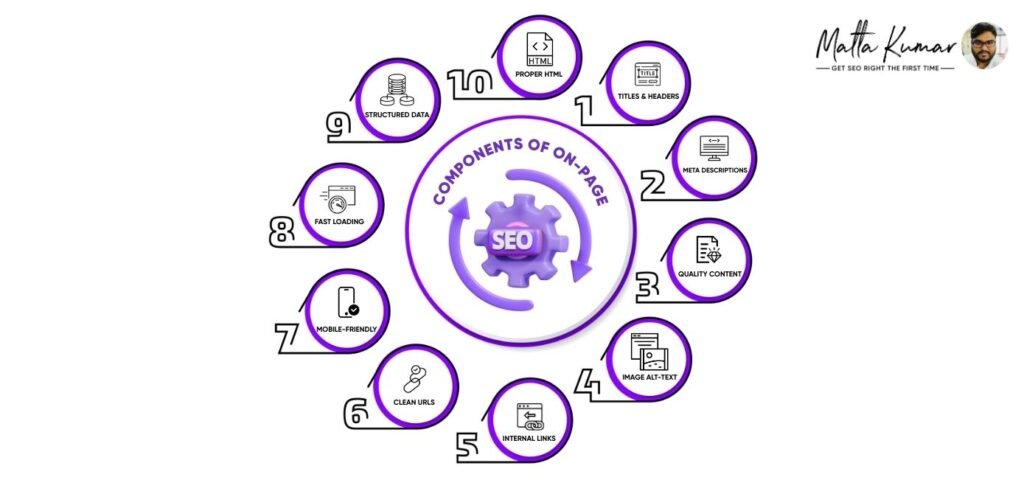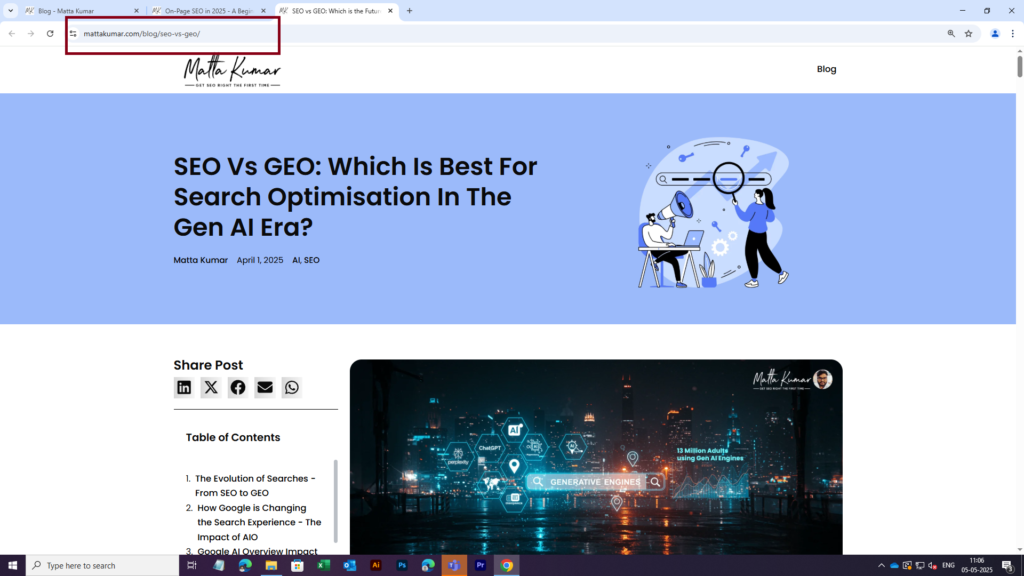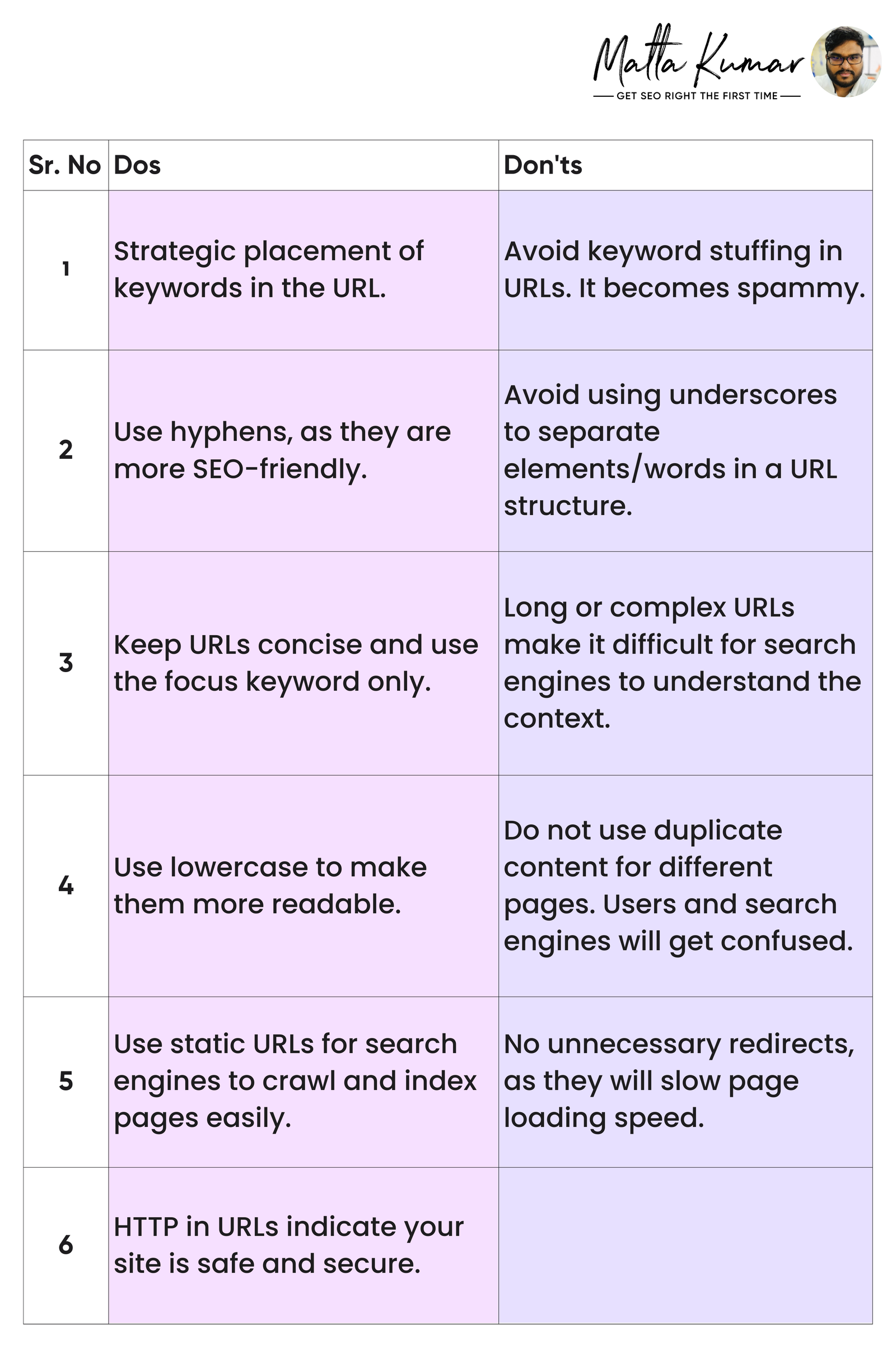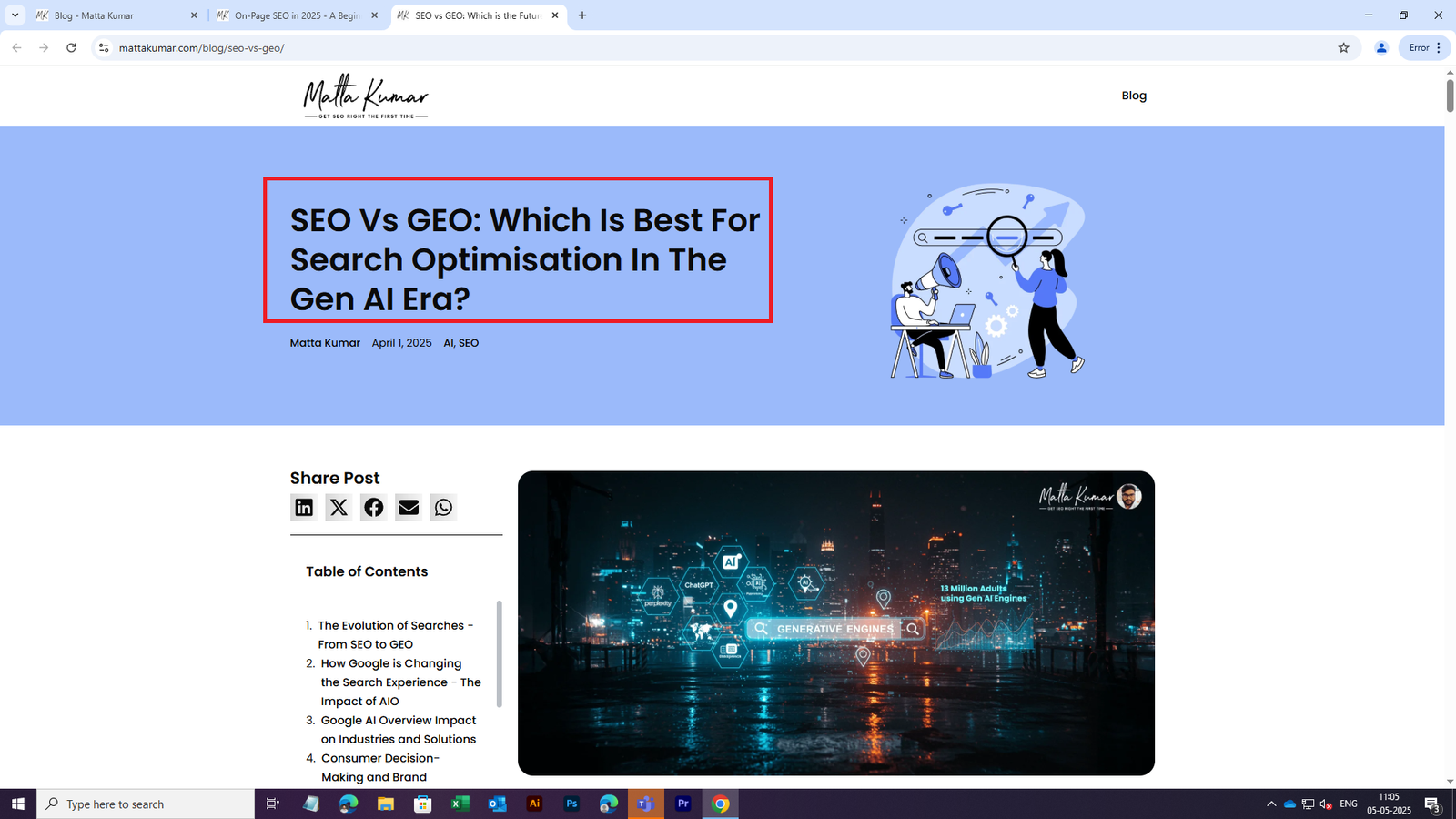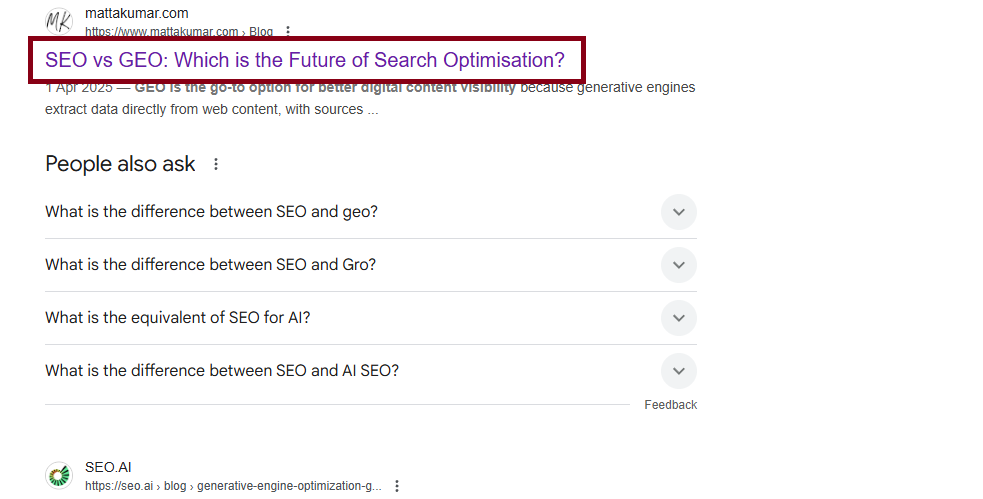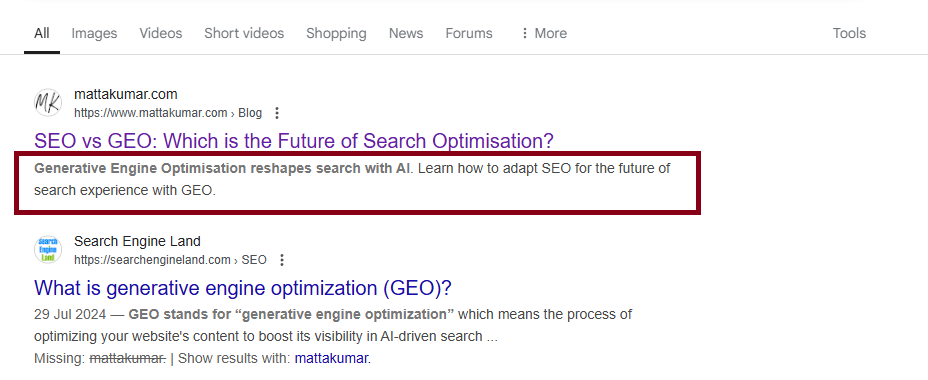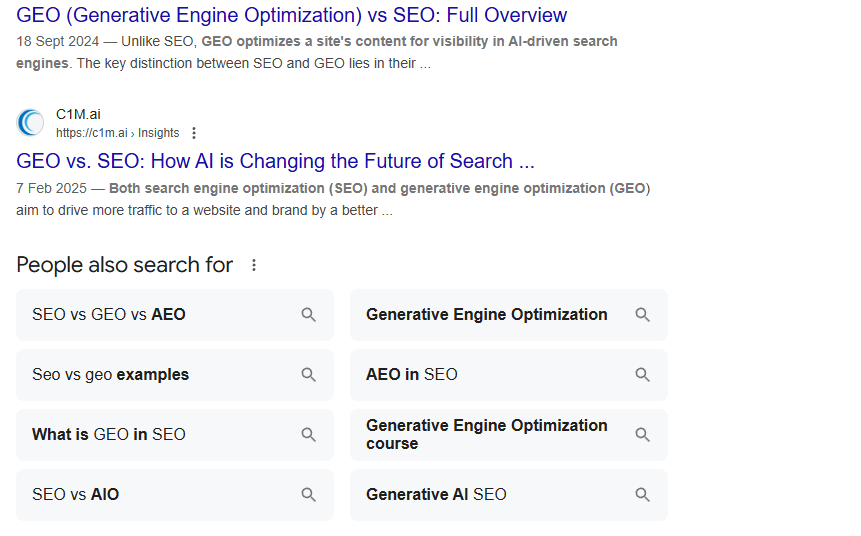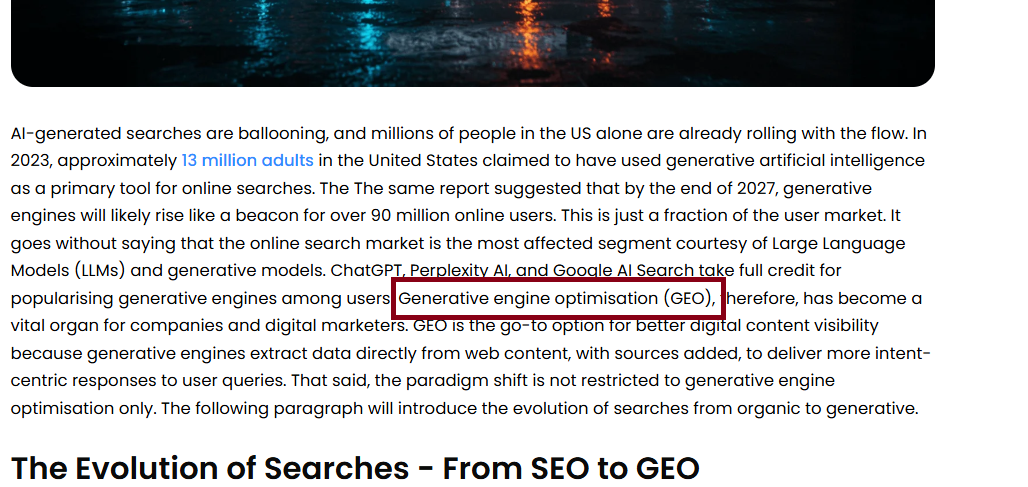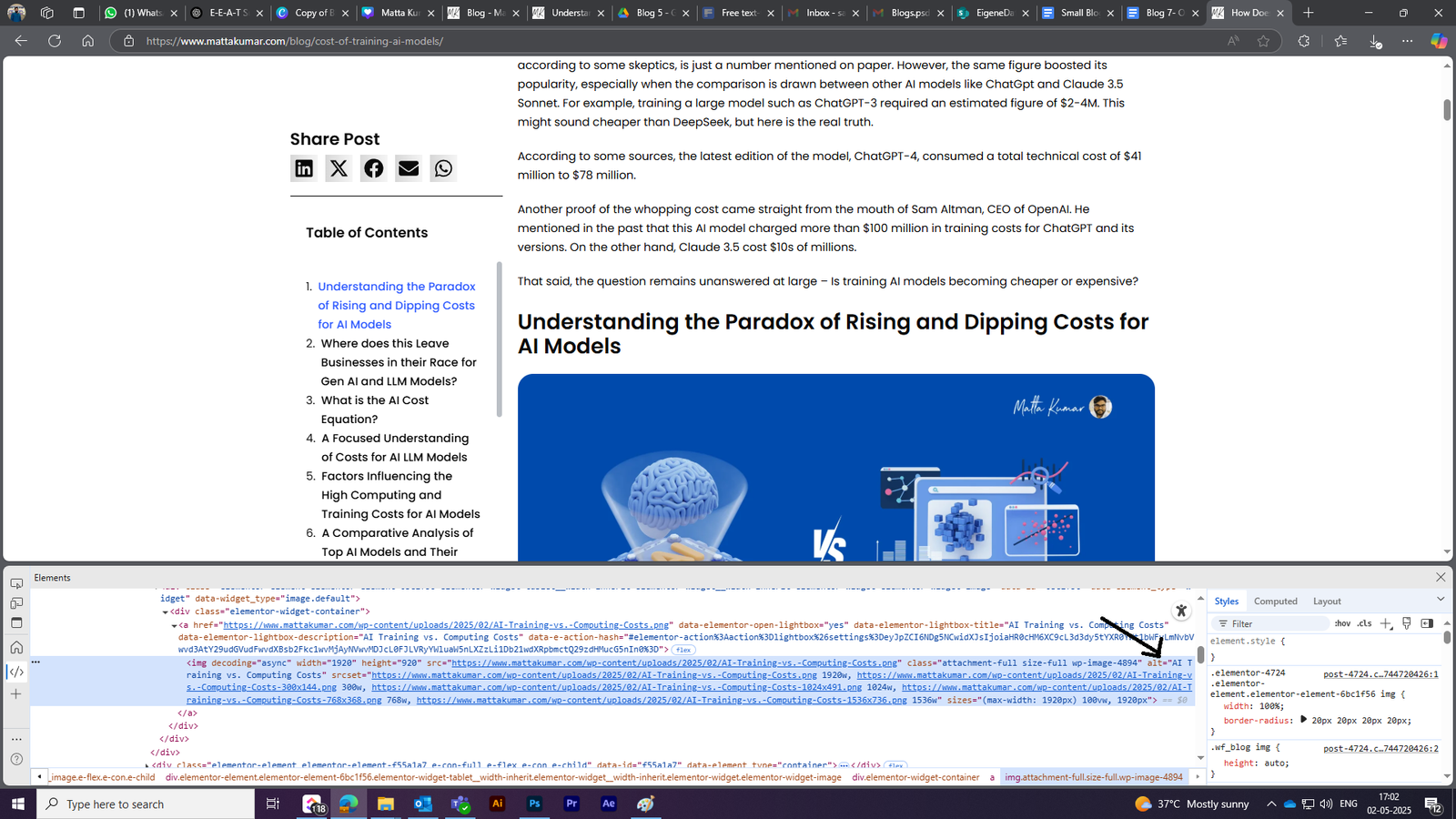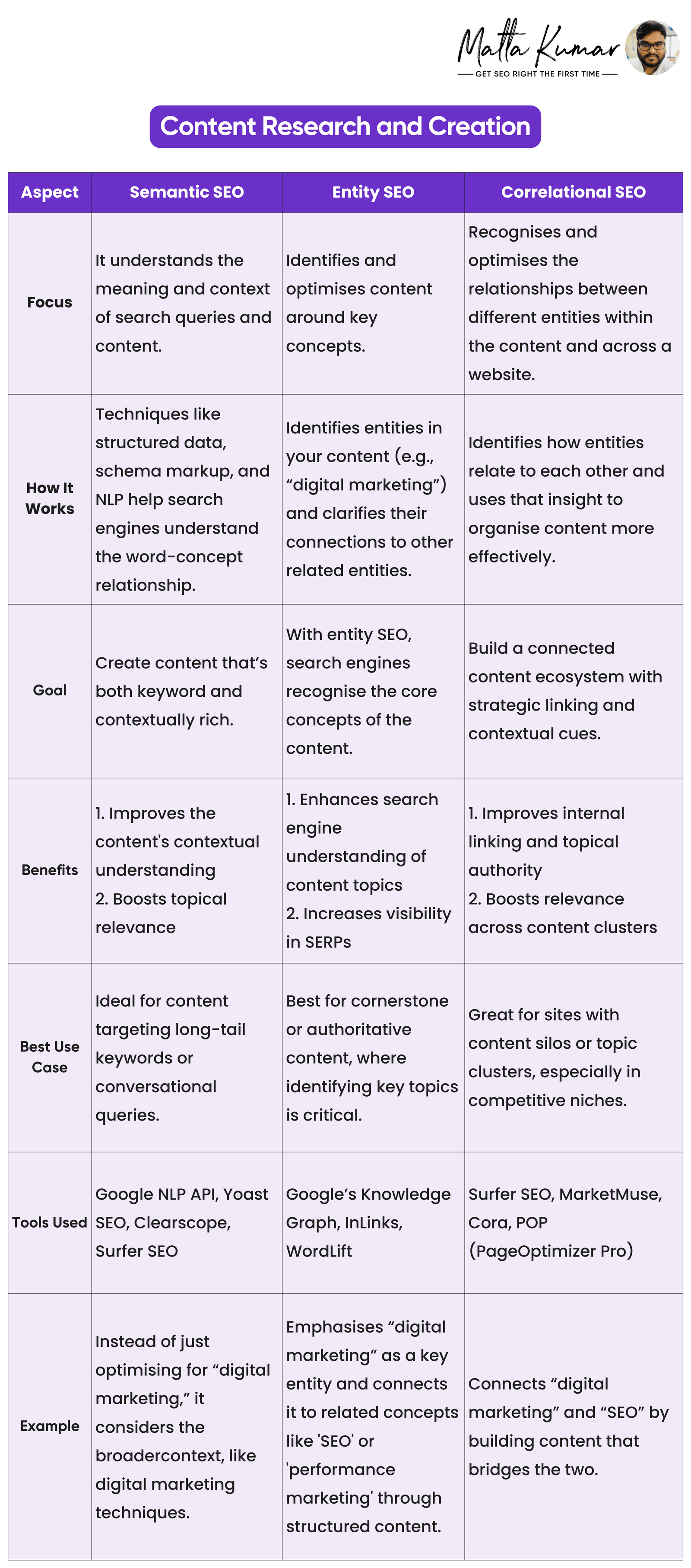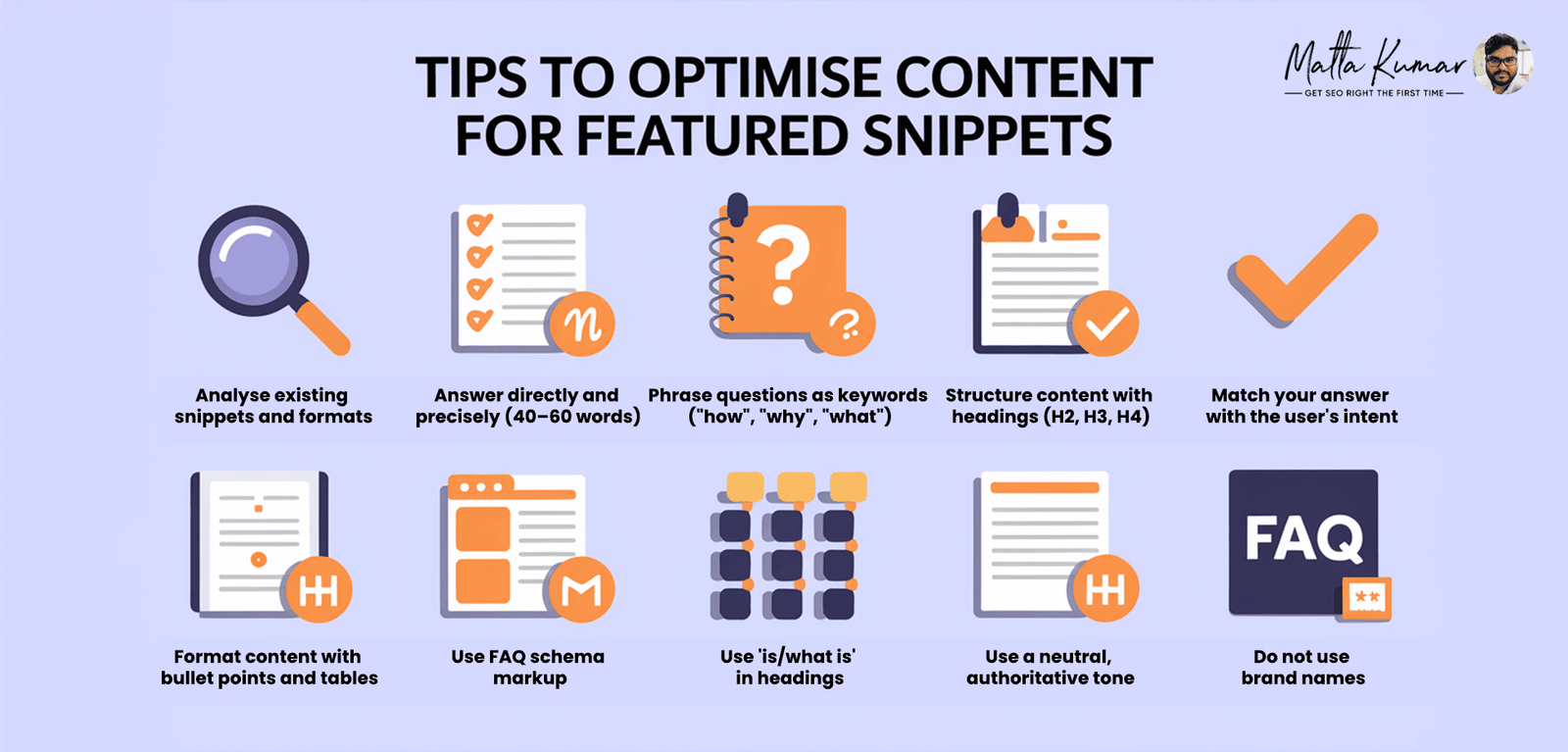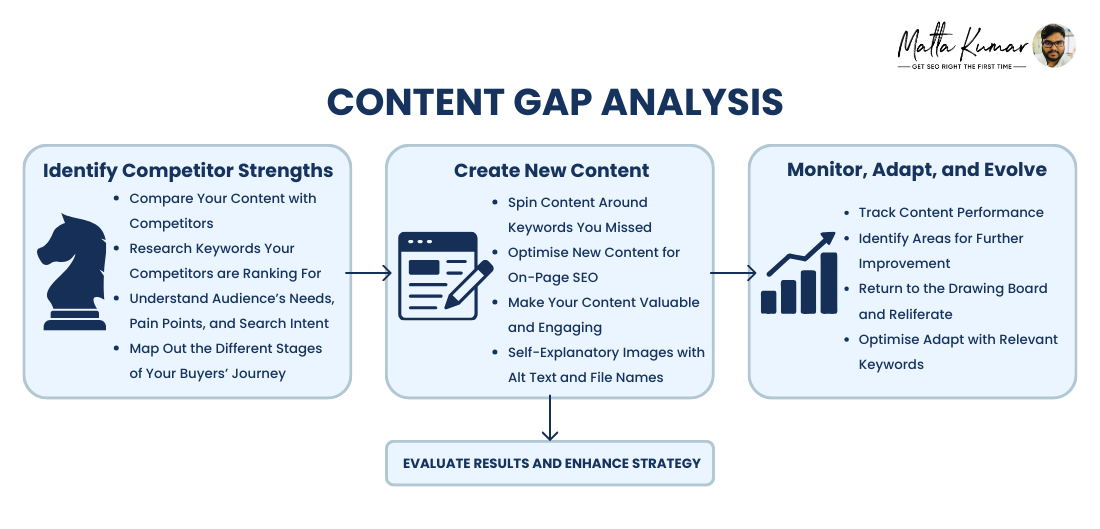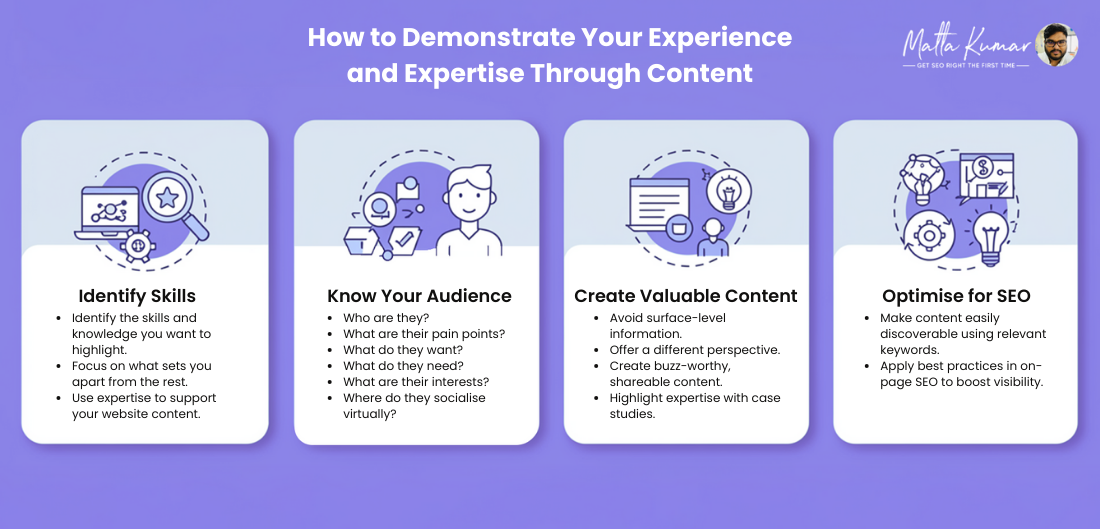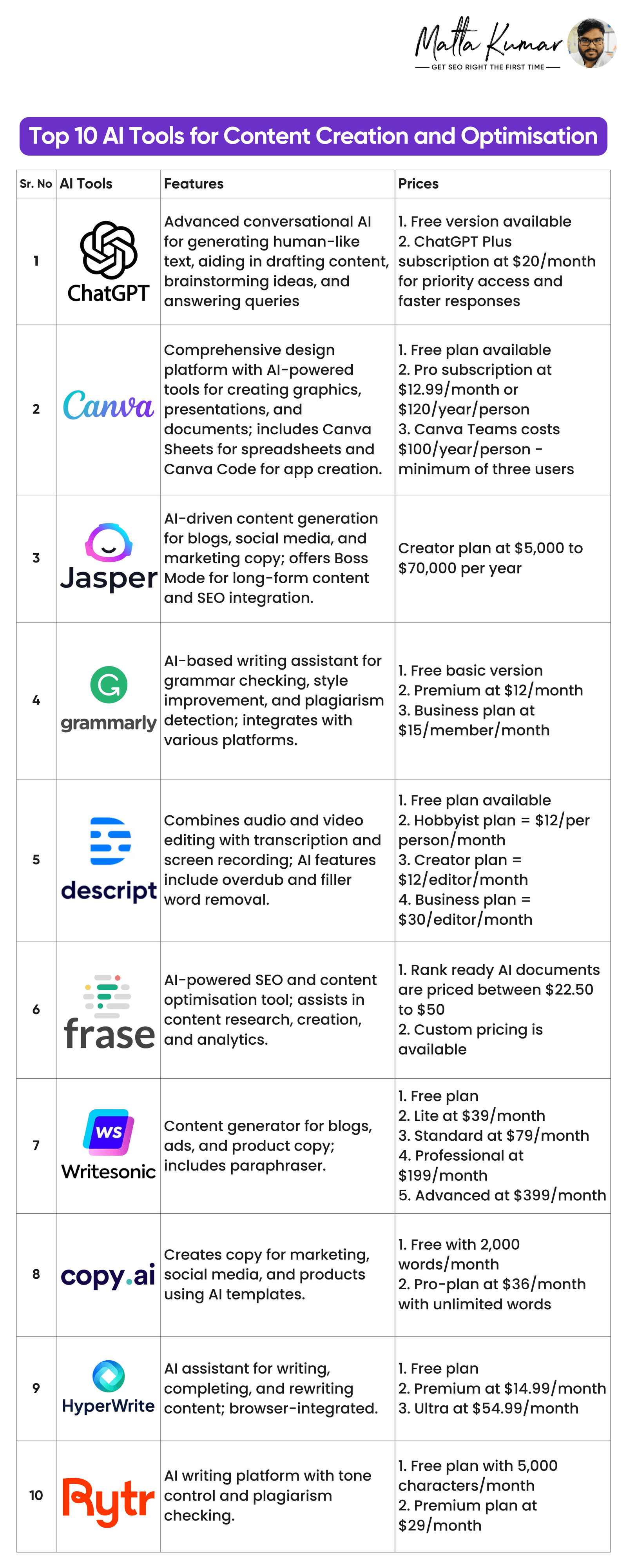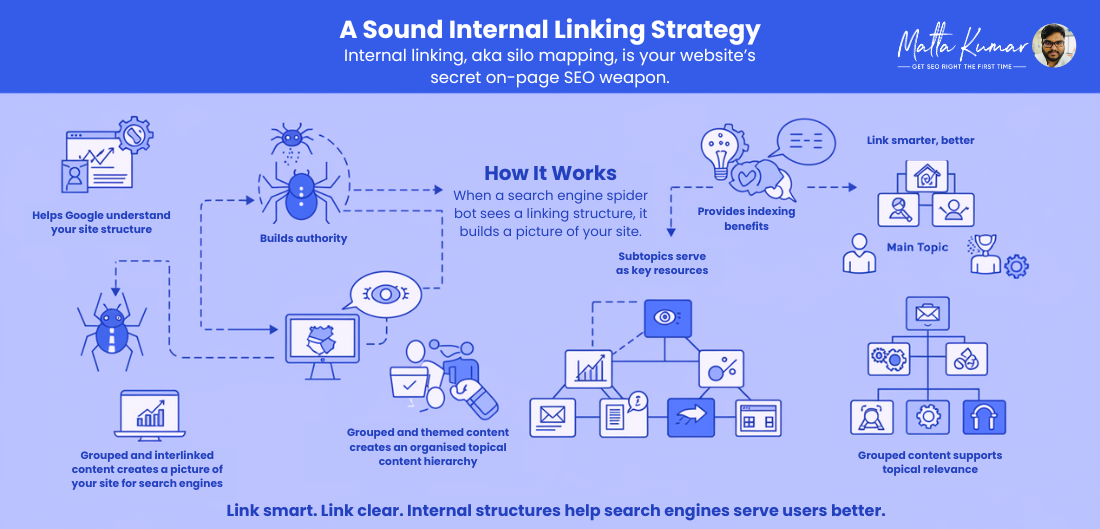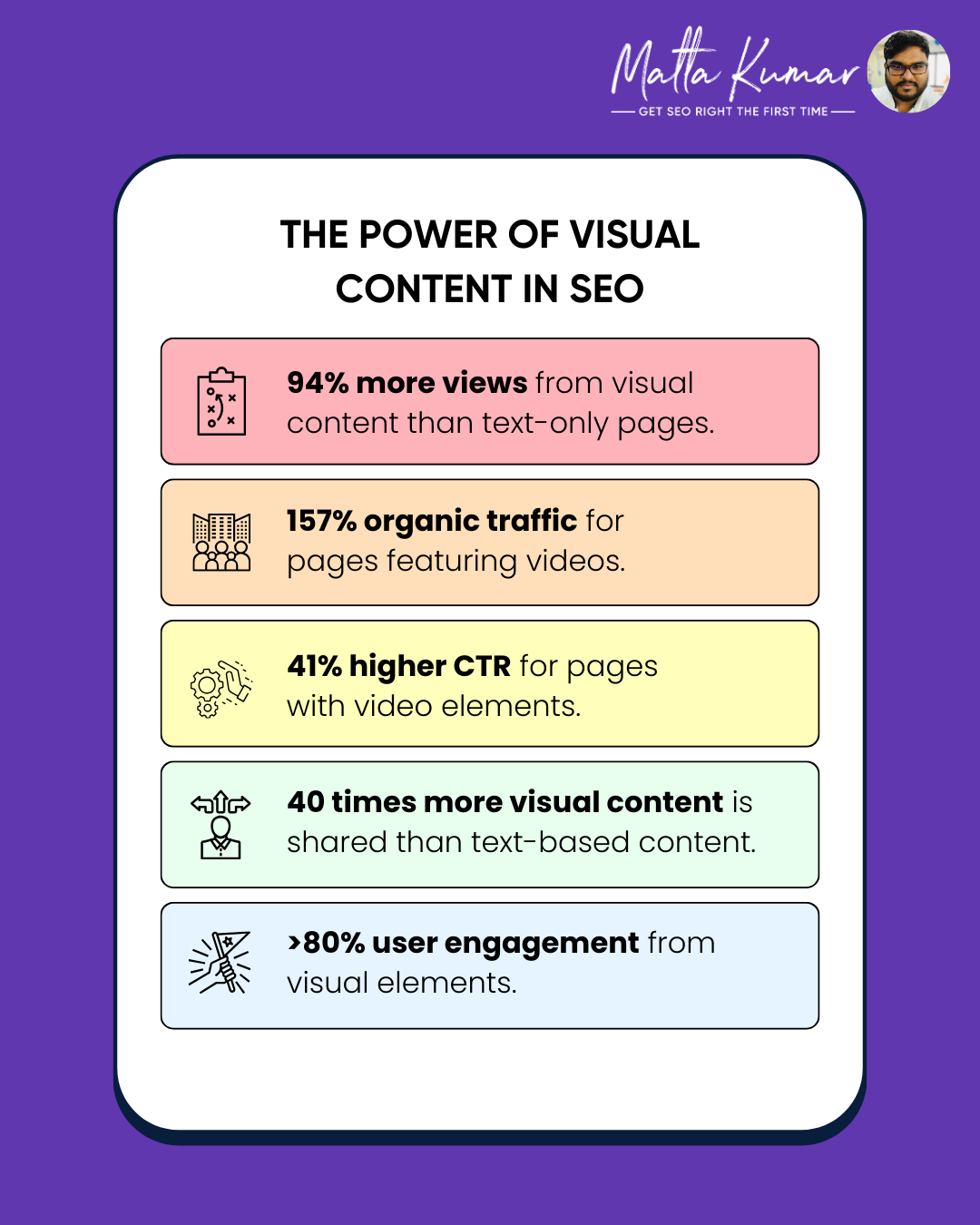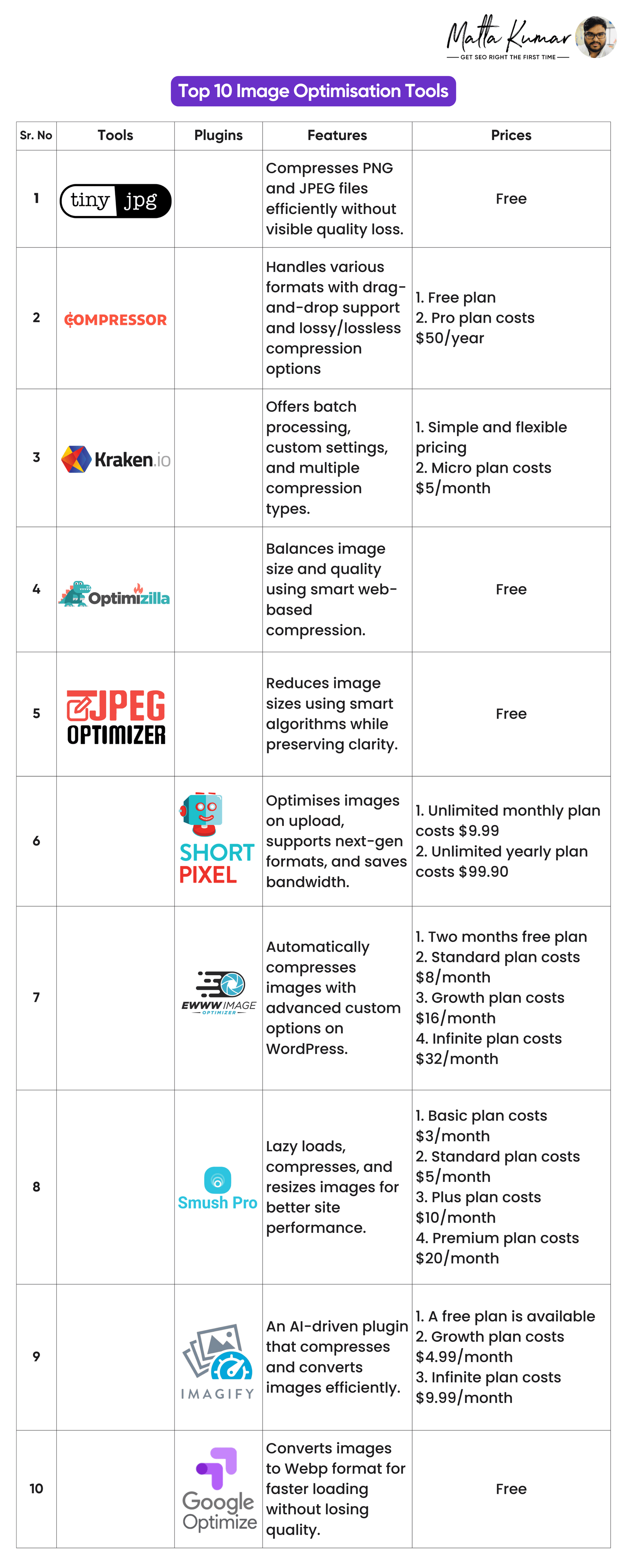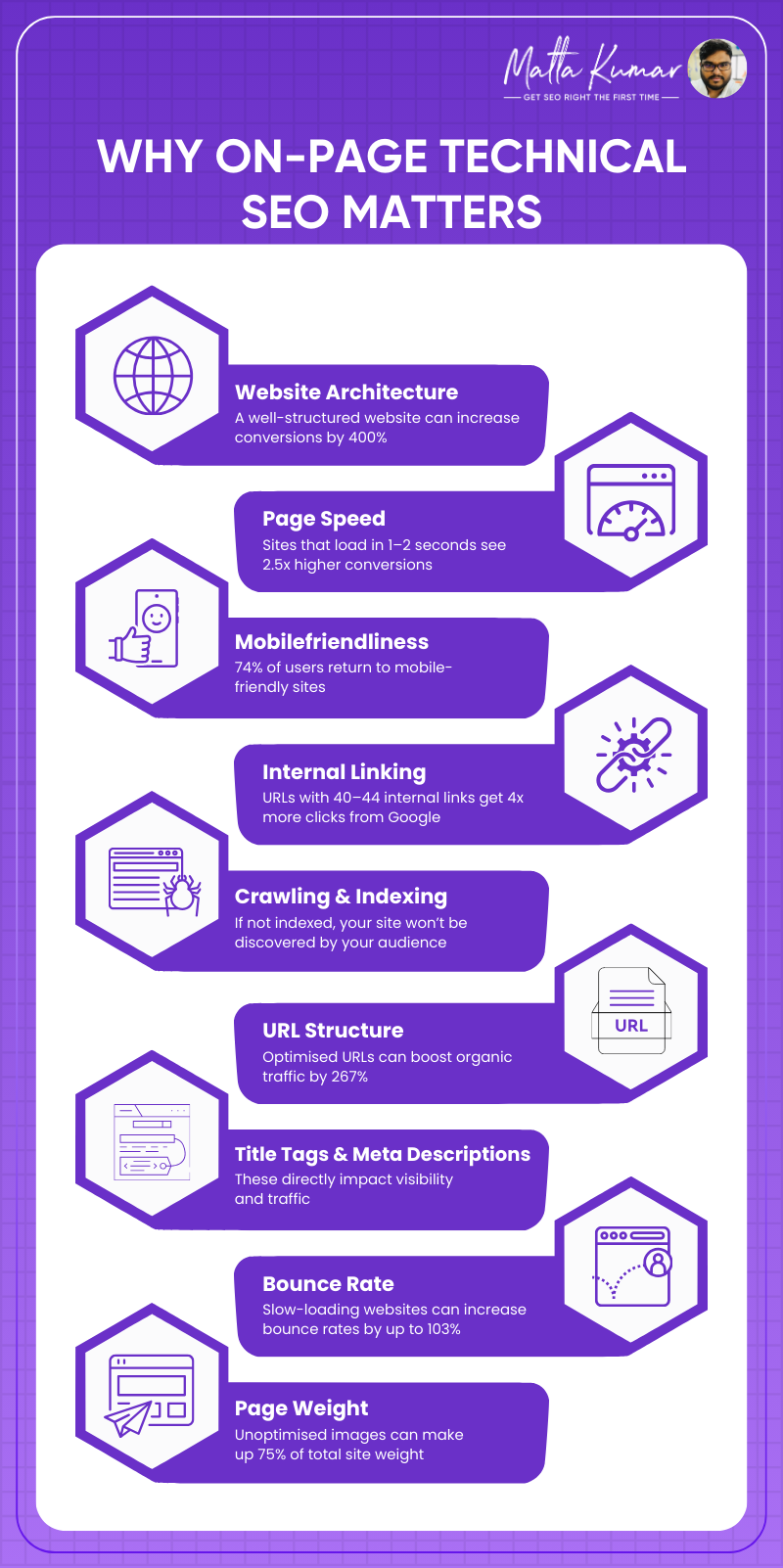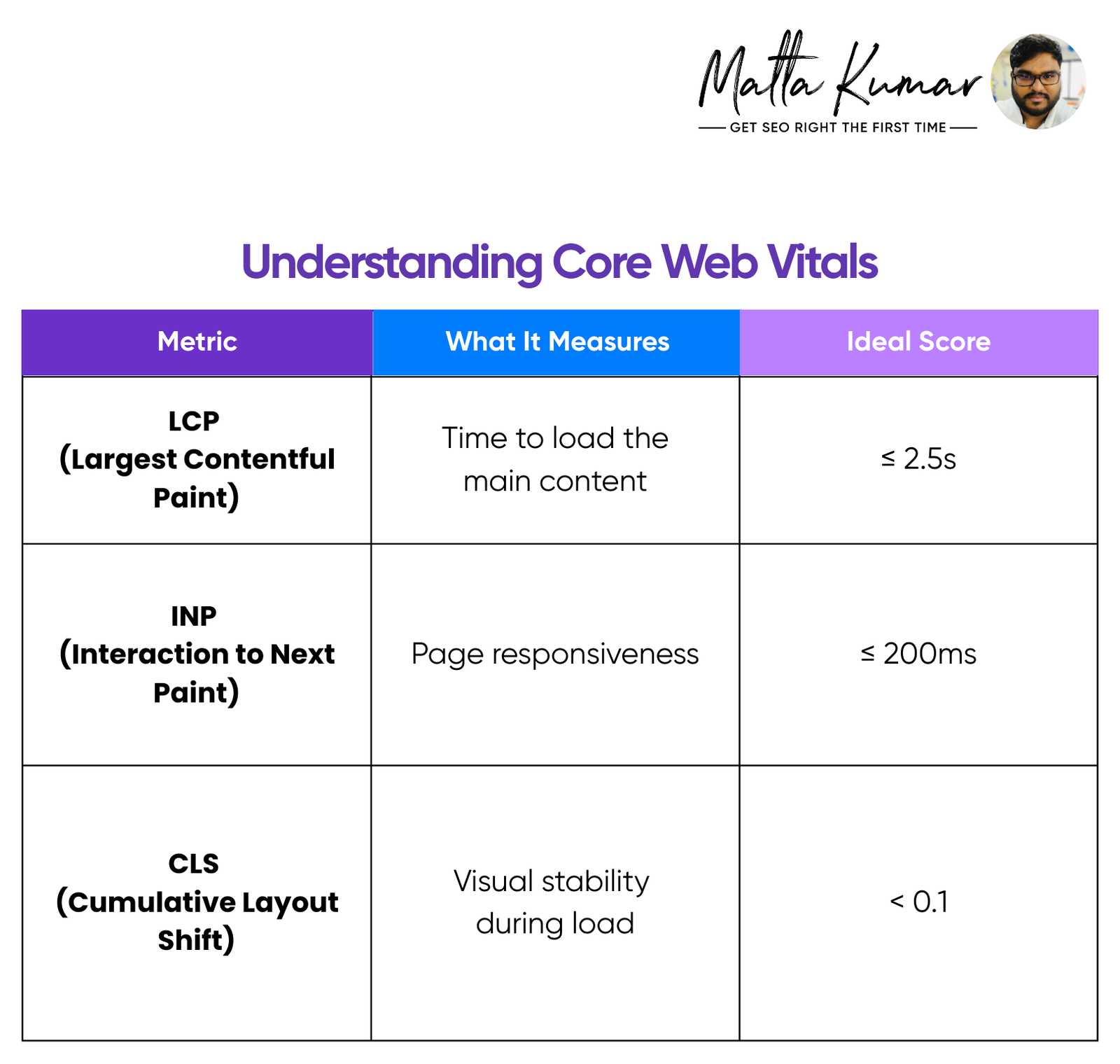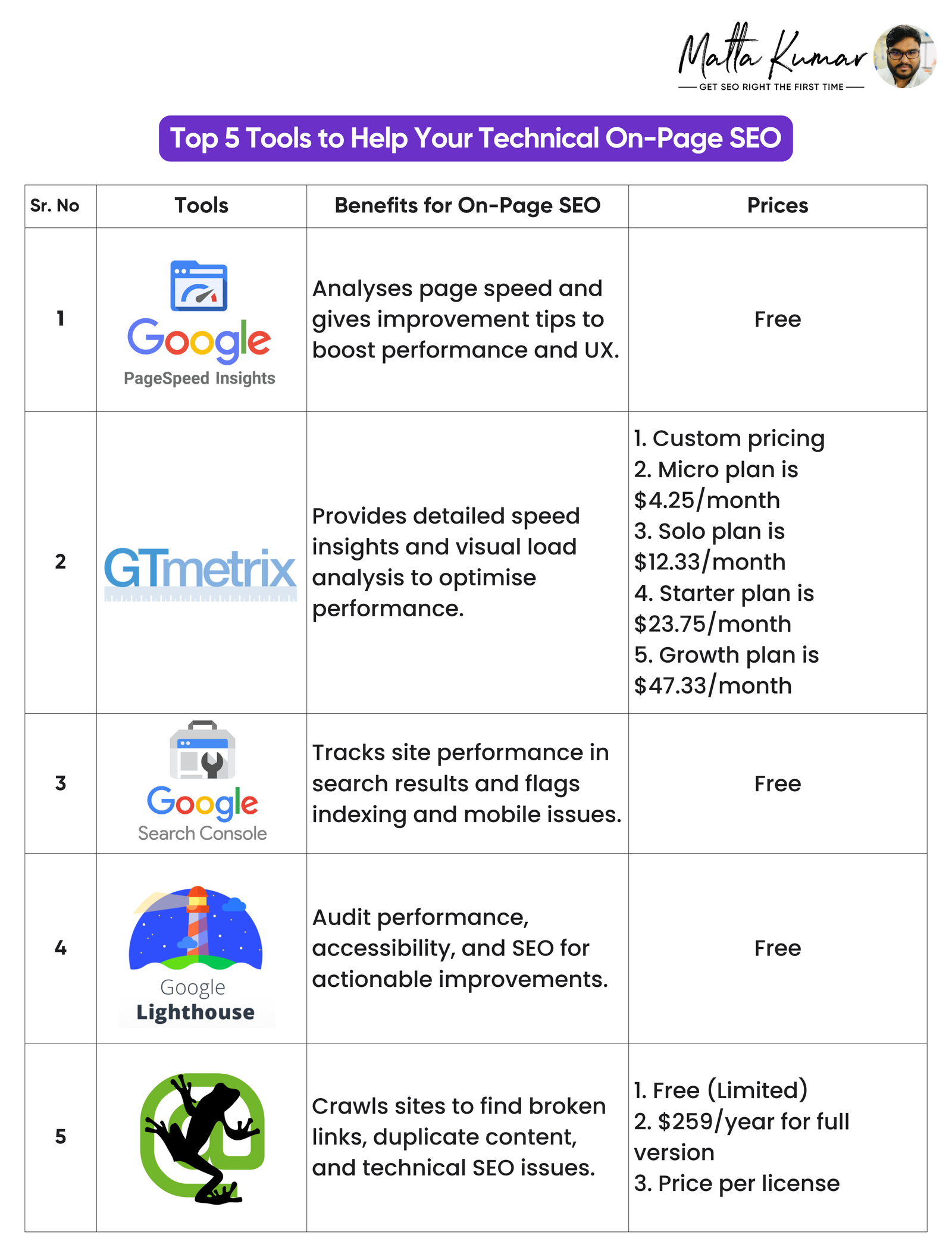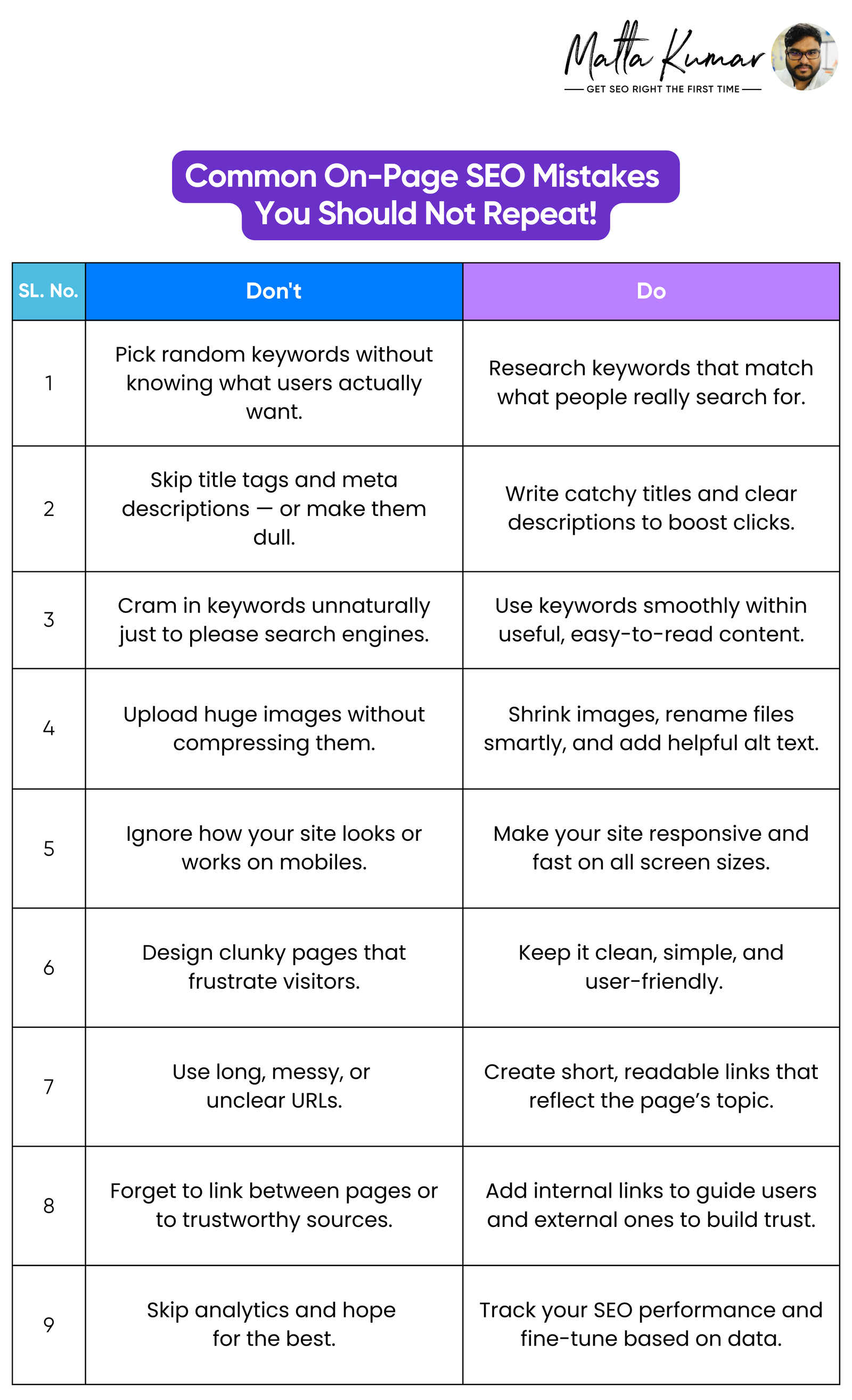On-Page SEO – The Ultimate Guide to Rank #1 in Google (2025)
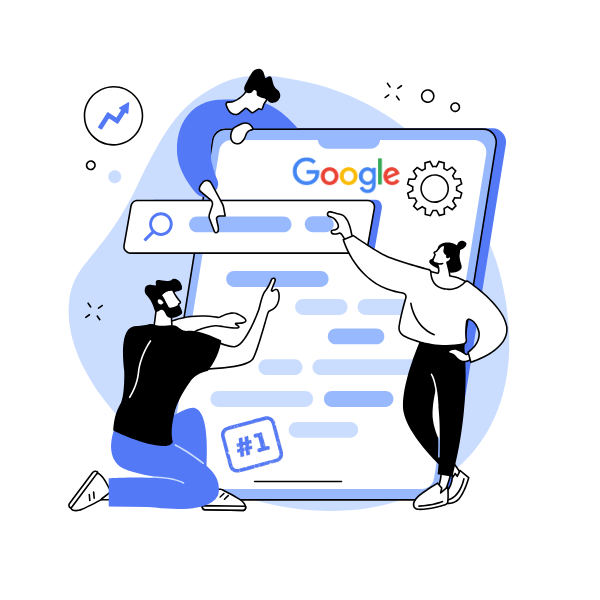
Share Post
Table of Contents
Search engine optimisation, or SEO as popularly known, is the foundation of digital marketing – the very framework on which your website’s online presence is built and shared organically. Without getting the fundamentals of SEO right, your content will not stand a chance of gaining visibility online amidst the horde of other pieces being uploaded every minute. Google alone handles approximately 402.74 million terabytes of data every day in the form of videos, images, blogs, articles, and other types of content.
How do you think your content will cut through all the noise on the Internet? The answer is search engine optimisation, of course.
Now, SEO is divided into two vital parts – On-Page and Off-Page. Both work together in synergy to make your website a fully optimised one from an organic search perspective.
This blog will cover the 101 of On-Page SEO that you should know!
What is On-Page SEO?
On-page or on-site SEO is an integral part of search engine optimisation that helps process your website pages and content according to search engine algorithms. These vital elements make your website search-ready, boost rankings, and gather organic traffic.
Optimising content for the search intent of your users, refining titles, headings, and meta tags with keywords, internal linking of pages for smooth navigation, and improving URLs for users to understand the context of your page are some of the key activities performed under on-page SEO.
Let’s recap the benefits of on-page SEO optimisation – how does it help your website/content?
Easy Crawling and Indexing
First things first – Google’s spider bots will not be able to crawl through your pages without proper optimisation. That means your web pages will not be discovered and retrieved. And if they are not discovered, how do you expect Google or other search engines to store and organise those pages in a searchable database? SEO does that for you!
10x Visibility and Traffic
Once successfully crawled and indexed, your pages/content are boosted for a higher position (rankings) on SERPs (search engine results pages) for the targeted keywords. Higher rankings imply more visibility among your targeted audience and more organic traffic, aka visitors, for your websites.
Give Your Visitors a Great Scrolling Experience
What’s your purpose in drawing visitors to your site? Simply visit and leave, or spend time navigating the pages? One of the fundamentals of SEO teaches about creating a user-friendly and navigation-friendly website/content, so users can have a positive experience scrolling down the page and take the necessary actions that you would want them to make from the page. Longer session durations, call-to-actions, and conversions measure user experience.
Win and Retain Your Audience’s Trust
On-site SEO focuses on building your website and content’s credibility on the Internet. This is an essential objective of SEO as a whole.
Simply put, customers/clients are very careful about trusting the content they read and believe on the Internet.
Ranking high on search results is a clear indication to your readers that your website has all the answers to their queries. Also, because the search engine has boosted your website rank, they easily trust your content as a reliable and authoritative source for information in the same industry.
However, without a good navigation experience, they will immediately quit your site. Higher bounce rates are bad for your business’s online reputation, as you will lose traffic and rankings faster than you had gained initially.
Competitive Advantage
A better website position on search results above your competitors means you gain a much larger market share comparatively. More customers will reach out to you because your site is visible in a position where their eyes fall first on a search result page. Effective SEO, and especially on-page strategies, can help your website outrank your competitors and automatically gain an edge over them in search results.
You have no idea how important it is to get the basics of on-page SEO correct, especially in 2025. Let’s help you feel its power.
In 2025, search engines have reincarnated into a one-stop shop for users to find exactly what they are looking for without having to click links and scroll through web pages. This is possible courtesy of generative search engines powered by AI technology.
Google, still the leader in the search engine category, has its own AI assistant, AI Overviews. The transition benefits not only users but also brands! Having your content featured in summarised answers on Google AI Overview at the top of the search results page means your page has the right authority and relevancy to satisfy user queries by exactly matching their search intent.
Additionally, Google’s helpful content update and other algorithm changes are working to boost content that is deemed the best answer for all search queries.
Also, Google uses the mobile version of your website first to index your pages. This is also termed as ‘user-first-indexing’ or ‘mobile-first-indexing.’ Developing a responsive website also falls under the on-page SEO banner. This aspect will determine your site’s rankings as well.
As you see, search engine optimisation has gone beyond just keyword matching, but on-page SEO remains the primary factor even in the gen AI era.
At this point, you might be wondering how. Well! The answer lies in on-page SEO elements.
- TItle Tags
- Meta Descriptions
- URLs
- Head Tags
- Content
- Structured Data
- Internal Linking
- External Linking
- Keywords
The above-mentioned elements help your website in the following ways:
- AI Overviews prioritise only relevant, comprehensive, and helpful content.
- On-page elements help search engines understand the context and relevance of your content.
- These elements increase your content's chances of being featured in AI Overviews.
- Links provided in the AI Overview summaries direct traffic to your website, even if the content features in the summary.
- The AI Overview summaries and links keep your website visible in relevant search results.
On-Page Vs. Off-Page SEO - Key Points of Differences
What is an On-Page SEO Checklist
Here’s your cheat sheet for key on-page SEO factors to optimise your website and increase its search performance 10X more:
Download the free checklist and boost your search rankings with confidence!
Top On-Page SEO Basics You Shouldn’t Ignore
In order for your page to rank higher on search engines, you have to ensure that every page of your website is 100% optimised before Google’s crawlers start their activities. Focusing on the key on-site SEO techniques and adding them to your website can help you achieve the same.
The journey begins with Keyword Optimisation.
Keyword Placements - Know the Right Places to Put Your Target Keywords
This stage begins with finding the most-suitable keywords for your website. There should be a proper strategy behind correct keyword placements, from your content to titles, URL structure, to meta tags.
- Keywords in URL
The URL of your web page gives your viewers a flair idea about the context. Hence, including your target keyword in the URL is a powerful on-page SEO ranking factor. Also, the URL structure should be search engine-friendly.
The title tag, often labelled with an H1 tag, is what users see prominently at the top of your page. The title tag is another vital on-page SEO element that requires proper placement of keywords and plays a major role in your on-page SEO.
Pro-tips:
- Put your focus keyword in the title.
- The title should be clear and concise, and directly articulate the page content.
- Use only one H1 tag per page. This is usually the page or post title.
The SEO/meta title is what appears on search engine results pages (SERPs). This is not visible on the page itself, but is vital for click-through rates.
Why do you need a meta title alongside the blog/page title?
- The SEO title helps you balance keyword use with click-worthiness.
- It allows flexibility in crafting a compelling message to attract users on SERPs.
Pro-tips:
- Keep it under 55–60 characters (including spaces) to avoid being cut off.
- Highlight a benefit or outcome.
- Use emotional triggers and powerful words.
- Include numbers, especially prime ones (like 11, 27, 31), when applicable.
Matching your SEO title and title tag also works, but the SEO title should be more persuasive to stand out in search listings.
Meta Descriptions
Earlier, meta descriptions created around the focus keyword were non-negotiable; not anymore.
Here’s why?
Google has been pulling snippets from your content. This means that even if you use an SEO plugin to write a meta description, Google may ignore it.
Even then, writing a keyword-rich, value-focused meta description is still worth doing. However, please don’t rely on it to always show on SERPs.
Subheadings (H2, H3, H4, etc.) break your content into readable sections and help Google understand the structure of your information.
Pro-tip: Use H2 for main section headings and H3 or lower for sub-sections.
Where to find related keywords:
- Search your target keyword on Google.
- You can also check the “related searches” section. This is present at the bottom of the page.
- Use relevant ones as subheading keywords to expand topical relevance.
Google values content that is well-structured and easy to understand, so organise your ideas under clear, keyword-optimised subheadings.
Keyword in the First 100 Words
Google should quickly understand what your page is about. Therefore, including your keyword in the first 100 words helps with quick indexing and ranking.
Pro-tips:
This strategy informs both users and search engines about the main focus of your content right from the start.
Keywords in Image Alt Tags
Google can’t “see” or read images the way humans do. Instead, it relies on alt-text to interpret them. Using descriptive alt text with your keyword (when relevant) helps improve SEO and image rankings in Google Image Search.
Pro-tips:
- Be descriptive and concise — imagine you are explaining the image to someone visually impaired.
- Include your keyword only when it naturally fits.
- Avoid keyword stuffing by mixing in related terms across different images.
How Content Optimisation is Executed for On-Page SEO
Content is still the unchallenged king of SEO.
Every website page has content, keywords, images, and links. They are correlated; however, content still gets the priority here.
Content strategy is extensive and all-inclusive – let’s divide the content optimisation strategy for SEO into essential sub-groups.
1. Keywords
Just like content, keywords are vital elements, and both depend on each other to help your website rank on search engine results pages.
But, here’s a catch – It is challenging to optimise for certain keywords compared to others. That said, your keywords should include a mixed bag of focus (branded and non-branded), long-tail and short-tail, and search intent (informational, navigational, commercial, transactional) keywords, segregated on the basis of search volume and keyword difficulty.
The foundational on-page SEO practice includes optimising title tags, meta descriptions, URLs, and headings with keywords. They help you get your pages indexed and noticed by search engines.
But as stated earlier, some keywords are challenging to optimise for and rank, especially competitive ones. Here, basic on-page tactics won’t always cut it. Why?
The reason is that not all keywords are created equal. Some are significantly harder to rank for due to high competition, search volume, and keyword difficulty.
You need a more strategic, data-driven approach that balances what Google expects with what your audience actually wants to read.
2. Content Research and Creation
In order to build a clean content strategy, you should know the three primary elements of content research and creation, namely, correlational SEO, semantic SEO, and entity SEO.
Here’s a brief overview explaining what each means from a content optimisation standpoint:
3. Content Structure (Schema)
Structured content refers to a set of HTML tags. They are also known as schema markups that help Google better understand what a webpage is about.
For example, when you Google a specific topic, you will see a page’s URL, title tag, and meta description.
However, sometimes search results will also display star ratings, customer reviews, and price range, especially if you are checking a hotel or a restaurant review online.
This is structured content in action.
These data are powered by schema markup.
Why do they matter? Well! Schema markups help search engines get more context about your page, which is then displayed directly on search engine results pages (SERPs).
Additionally, structured content also makes your page stand out on SERPs using additional elements like ratings, FAQs, or product information.
These enhancements make your listing more appealing and increase your click-through rate (CTR), regardless of your position on the results page.
Types of Schema Markup
Depending on your content, there are various schema types to choose from:
- Article
- Breadcrumb
- Event
- FAQ Page
- How-to
- Local Business
- Organisation
- Person
- Product (for offers, aggregate ratings, reviews)
- Recipe
- Video
- Website (for sitelinks)
A pro tip: There should be an alignment between your schema, target keyword, and the content type intended for ranking on the SERPs.
How to Implement Schema on Your Website
Before adding schema code, identify which pages require it.
Start with a site audit to pinpoint high-value pages while ensuring you have access to Google Search Console (GSC) and Google Tag Manager (GTM).
Additionally, plan a nested schema structure based on your website’s hierarchy. Map out your site architecture with main categories, subcategories, and their relationships.
A typical structure would look like this: Homepage > Category > Subcategory > Product.
Assign appropriate schema types accordingly:
- Webpage for the homepage
- Item list for category and subcategory pages
- Product for individual product pages
- Article for blog posts
- About page for the About Us section
4. Content Formatting
Your content can rank higher and truly resonate with users only when your on-page strategy goes beyond keywords.
Here are a few pro tips to enrich and optimise your content to be user-first-focused and search engine-friendly.
Content formatting for SEO is equally important. The latter implies making your content more readable for search engines.
A few best practices for an ideal content format include:
- Give clear headings with relevant keywords
- Break down the content into H1, H2, H3, and so on...
- Keep the paragraphs brief but deep and informative
- Divide the content into bullet points - readers can easily understand
- Use keyword and topic-focused images with apt Alt Text
- Incorporate relevant keywords naturally
5. Content Depth & Relevance
Your content can rank higher and truly resonate with users only when your on-page strategy goes beyond keywords.
Here are a few pro tips to enrich and optimise your content to be user-first-focused and search engine-friendly.
1. Smart Keyword Research & Planning
- Think like your audience: Discover what your customers are actually searching for from keyword tools and forums.
- One Page, One Theme: Keep your content focused. A single keyword or topic for each page will not confuse Google.
- Outline Like a Pro: Map out your content before you start writing.
Also read: How to Do Keyword Gap Analysis .
2. Create Content That Actually Helps (And Ranks!)
- Be Original. Be Useful. Be Awesome: Don’t just copy, paste, and rephrase what’s already out there. Add your unique spin to deliver real value.
- Use Keywords Naturally: Add main and related keywords where they make sense.
- Craft Click-Worthy Titles & Meta Descriptions: Your SEO titles and meta descriptions are SEO-friendly and irresistible to click.
- Break It Down with Headings: Use H1s to H6s to give your content structure to help readers and search engines.
- Make URLs Clean and Clear: URLs should tell people (and Google) exactly what they’ll find on the page.
- Link Smart: Add internal links to guide readers through your site, and drop in external links to credible sources that back up your claims.
- Don’t Forget the Visuals: Use images, charts, and infographics to break down your content into readable sections.
3. Add Depth That Actually Satisfies
- Be the Final Answer: Give users everything they need to walk away satisfied. Go deep and cover all the nuances.
- Bring in the Experts: Reference reliable sources to give readers (and Google) more reason to trust you.
- Keep It Fresh: Keep your content up to date so it stays accurate, timely, and relevant.
- Make It User-Friendly: Clean formatting, easy navigation, and clear takeaways make a smoother user experience.
- Measure, Tweak, Repeat: Use tools like Google Analytics and Search Console to see what’s working, what’s not, and adjust as needed.
Topical Authority
Google loves an authoritative website and demonstrates it.
Here’s a complete guide that provides a smart, strategic content plan that search engines will trust and readers will keep coming back to.
- Define your niche and own it.
- Create content clusters that work like a web.
- Go in-depth and back your claims with facts.
- Add visuals and real examples to make your content digestible and more fun to read.
- Match your content with user intent.
- Stay current and trustworthy.
- Attract backlinks that actually matter.
- Create link-worthy content that offers insights, data, or resources people want to share.
- Track keyword performance.
- Check your traffic sources.
FAQs
Frequently asked questions are perfect to capture the user’s interest. Also known as Faqs, these vital on-page SEO elements can help search engines easily understand the website content and increase the chances of your content appearing as Snippets on Google SERPs.
Faq schema markup not only elevates user experience but also boosts the site’s visibility and organic traffic.
The Strategy Behind FAQs
Follow the below-mentioned steps to create your website’s faqs.
- Identify common customer questions.
- Provide clear and concise answers.
- Structure the page logically.
- Optimise title tags and meta descriptions.
Tips to Optimise Content for Featured Snippets
When your content appears on featured snippets, your website automatically attracts more virtual foot traffic.
Content optimisation for featured snippets can be an effective on-page SEO strategy, and this is how you do it:
A point to remember – Now, featured snippets are fine-tuned with voice search. Devices like Google Home should read your featured snippet as a regular answer to user queries.
How to Fill Content Gaps
Content gap is the difference between what users are exactly searching on the Internet versus Outwhat response they are receiving. For example, the underperforming content on your website might indicate a content gap. Possibly, your website is not covering topics or questions your target audience is searching for.
The content gaps can be easily filled. Here’s a small guide for you to refer:
How to Demonstrate Your Experience and Expertise Through Content
The success of your on-page SEO also depends on your content and your authority on the particular topic. Both are intertwined and should be carefully articulated to build your readers’ trust and draw them back to your website for more!
Follow the steps to represent the same through your content:
Internal linking, aka silo mapping, is your website’s secret on-page SEO weapon.
Internal linking is super easy to implement, but you have to plan it right.
How does it work?
Google tries to build a picture of your website based on topical authority. Writing multiple posts to develop your topical authority might not be enough, especially when the posts don’t interlink with each other. In short, you are making Google work harder than it should.
However, linking relevant pages together allows Google spider bots to crawl and index your content faster and more accurately.
In order to interlink related pages, you’ll want to use a silo structure.
Now, what does silo structure mean in on-page SEO?
Simply put, when content is grouped and interlinked by topic, a silo structure is formed. This creates a clear, organised flow for both users and search engines.
An important takeaway: Even if they don’t transfer PageRank to your website, outbound links connecting your pages to high-authority websites actually help boost your site’s credibility and relevance.
Image Optimisation for Your On-Page SEO - A Brief Overview
Visual content has a high impact on your on-page SEO.
Don’t believe it? Check the statistics below:
Now that you know why visuals are relevant for on-page SEO success, let’s traverse the next important section – How to make visual elements easily searchable and discoverable?
Here are a few on-page SEO elements for image optimisation:
- Use self-explanatory and keyword-focused file names.
- Alt text should be concise and relevant.
- Implement schema markup, so search engines can understand your images.
- Your sitemaps should include images for easy discovery.
- Images should be responsive to all devices and screen sizes.
- Page context should match your images.
- Focus on image size and format to improve page load speed.
Top 10 Image Optimisation Tools
On-Page Technical SEO - Essential Things to Know
On-page technical SEO is about including internal elements to your website and making it sing. From structuring your site to speeding up its loading time, every detail matters for better search rankings. In short, you are simplifying the process of crawling, understanding, and indexing the website for Google bots.
Why is on-page technical SEO important?
The statistics will tell you:
Page Speed & Core Web Vitals: A Quick Guide to Better On-Page Technical SEO
Fast-loading pages are a necessity for technical on-page SEO. Why?
This is because your visitors will stick around longer.
Not just page speed, Core Web Vitals also impact your search rankings and change how users experience your website.
Let’s break down why they matter and how to optimise them.
a. Why Page Speed Matters?
- Page speed is an indispensable ranking factor.
- Slow pages drive users away from your website.
- Load times should be under 2.5 seconds.
- Fast loading gives a smooth user experience.
- Anything over 4 seconds is POOR.
b. Understanding Core Web Vitals
They are essential metrics for Google to analyse your site’s real-world performance.
If your website achieves the ideal score for each metric under web vitals, the site will have a better chance of ranking high on SERPs.
The best scores, according to Google, are:
C. Tips to Improve Your Web Core Vitals Score
d. A Few Best Practices to Improve Speed & Stability
- Compressed Media: File sizes of images and videos should be reduced to retain the site's loading speed without disrupting quality.
- Streamlined Code: Eliminate extra characters from CSS and JavaScript to make your site fast and smooth.
- Caching Enabled: Store key website resources in the browser to reduce load time for returning visitors.
- Fast Hosting: Select a reliable, high-speed hosting provider to improve site performance and uptime.
- Server-Side Rendering: Put dynamic content on the server to increase load speed and search engine visibility.
Mobile Friendliness & UX: A Must-Have for On-Page SEO Success
Your target audience can be iPhone users or those who prefer searching for information from their MacBook. Some can use their Android mobiles to check your site.
Only a responsive, mobile-friendly website design can give your target audience the same effortless experience regardless of which device they are using to search for you.
Google and other search engines prefer companies whose websites offer the same.
Responsive design, mobile-friendliness, and intuitive navigation are key factors that increase the chances of your technical on-page SEO success.
This is what you should know to extend your reach, retain, and convert visitors into lifetime buyers:
- Responsive Design: An adaptive layout that matches different screen sizes.
- Thumb-Friendly Buttons: Larger, well-spaced buttons improve the navigational experience on a small screen.
- Clear, Readable Fonts: Clean typography doesn't hurt a visitor's eyes. So they stay longer on your page, and this signals value to search engines.
- Visible, Easy-to-Tap CTAs: Call-to-action buttons should be placed exactly where your target audience makes a purchase decision.
- Consistent Spacing & Layout: Balanced design reduces layout shifts and supports Core Web Vitals like CLS (Cumulative Layout Shift).
- No Horizontal Scrolling: Mobile users expect vertical flow. Forceful side-scroll leads to a poor experience and lower SEO performance.
Top 5 Tools to Help Your Technical On-Page SEO
Common On-Page SEO Mistakes You Should Not Repeat!
A few common errors are expected when you are starting with on-page SEO. Knowingly or unknowingly committed, these errors can prove a massive disaster for your website’s online presence and the brand’s reputation in the market.
Here are a few dos and don’ts for you to remember:
Conclusion
If you have read the entire on-page SEO guide, you are one step closer to building a strong position for your website online.
On-page SEO is fairly technical and might seem a tad bit boring for many. But it is the most crucial element in digital marketing. Ignoring on-page SEO features can easily push your website from the first page of Google’s SERPs and other search engines.
Remember, SEO is not a one-time game. So, memorise the techniques verbatim and be ready to dominate search engines.
Download the on-page SEO checklist and stay one step ahead of your competitors.
FAQs
- What is on-page SEO?
Ans: On-page SEO involves optimising individual web pages to boost rankings and improve user experience.
- What is the basic SEO on-page?
Ans: It’s about using the right keywords, meta tags, content structure, and internal links to help search engines understand your page.
- How to do proper on-page SEO?
Ans: Start by researching keywords, writing high-quality content, using clean URLs, and improving page speed and mobile-friendliness.
- How can I start SEO as a beginner?
Ans: Learn how search engines work, pick the right tools, and practise by optimising your website step by step.
- What is the 80-20 rule of SEO?
Ans: It means 80% of your SEO results often come from 20% of your efforts—usually strong content and smart keyword use.
- What is a bad SEO score?
Ans: Any score below 70 generally signals technical issues or poor content that could hurt your site’s performance.
- What is the golden rule of SEO?
Ans: Always create content for users first, then optimise it for search engines.
- What is the 10x rule in SEO?
Ans: Your content should be ten times better than anything else ranking for your target keyword.
- How to calculate SEO score?
Ans: Use tools like SEMrush, Ahrefs, or Moz, to analyse factors like speed, mobile use, backlinks, and keyword presence.
- What is SEO frequency?
Ans: It refers to how often you update your content or optimise your website to stay relevant and visible in search results.

